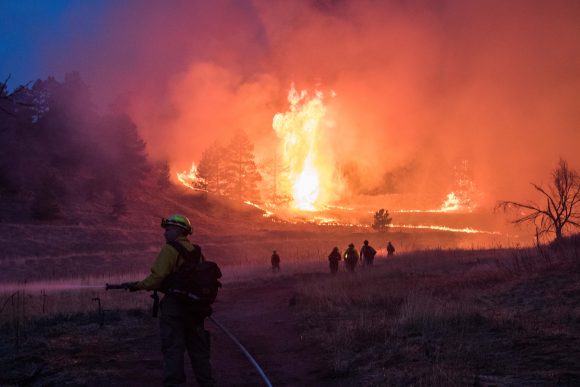
Firefighters spray down dry brush near Settlers park to try and contain the Sunshine Canyon fire on March 19, 2017. (Jackson Barnett/CU Independent)
Popular media constantly depicts Mars as a burnt orange, dusty red planet that appears scorched by the Sun. Never would I have thought that the same description would fit Boulder’s sky. Last week, I was driving to the grocery store when ash began to fall on the windshield, and the smell of smoke filled the car. A dim red glow covered the mountains and the trees.
The planet is literally on fire and according to scientists, there’s no going back after this.
CU Boulder recently updated its website with new information in regards to the erratic fire season and provided guidelines in order to prevent more wildfires. While this information is important, a bigger conversation surrounding the lasting effects of these fires is more necessary.
The city of Boulder released an analysis of the impacts climate change will have on the county back in 2018. Included in that analysis is the fact that climate change will make wildfires more likely not just in the state, but in the city as well. This means those Instagram pictures everyone loves to take at Lost Gulch may not look so good anymore when all the trees are burnt down.
Colorado is experiencing some of its largest wildfires in the state’s history, with the Pine Gulch fire breaking the record at 139,007 acres just north of Grand Junction. And if the fires weren’t making climatic conditions worse, state climatologist, Russ Schumacher says that 2020 is Colorado’s fourth driest year on record and 99% of the population is facing a drought. More than 175,000 acres of land have burnt down this summer and the largest wildfires continue to wreak havoc on the Front Range. This is not just some extraordinary circumstance.
The planet is heating up at an alarming rate due to greenhouse gases such as carbon dioxide, making the climate out West drier and more susceptible to wildfires. The summers are getting hotter, the yearly snowpack is decreasing, and wildfires will only become wilder so long as we do not reduce our carbon emissions.
Natural wildfires are good for recycling the soil and getting rid of dead litter on the ground. However, when a fire burns for too long, and the ground remains too dry, the ecosystem cannot recover. When the new generation of trees are supposed to sprout after a wildfire and fails to grow, the land is placed in a vicious positive feedback loop: more heat absorption into the ground, increased surface temperatures, and more negative effects of global warming result. Not to mention there will be fewer trees to act as a carbon sink and more carbon will be trapped in the atmosphere.
With increasingly dry conditions, the wildfires are expected to continue well into October, and there is little hope for the Western landscape to regrow back to normal. Seedlings will not have the opportunity to sprout and flourish in scorched soil and a severe drought. Much of our beloved Arapahoe and Roosevelt forest here in Colorado could be charred soil for years to come.
The year 2020 may be full of uncertainty. But if there is one thing that is certain, it’s that the environment is starting to collapse. Individual and institutional change is required if we want to continue ski trips in the Rockies or camping in the forests. Small lifestyle changes like decreasing your carbon footprint and adapting your mindset to thinking more globally and sustainably can make a huge difference in the long run.
Scientists and climatologists warned us for years that the Earth is slowly deteriorating. Perhaps it’s happening much sooner than they thought.
Contact CU Independent Staff Writer Savannah Mather at savannah.mather@colorado.edu.
